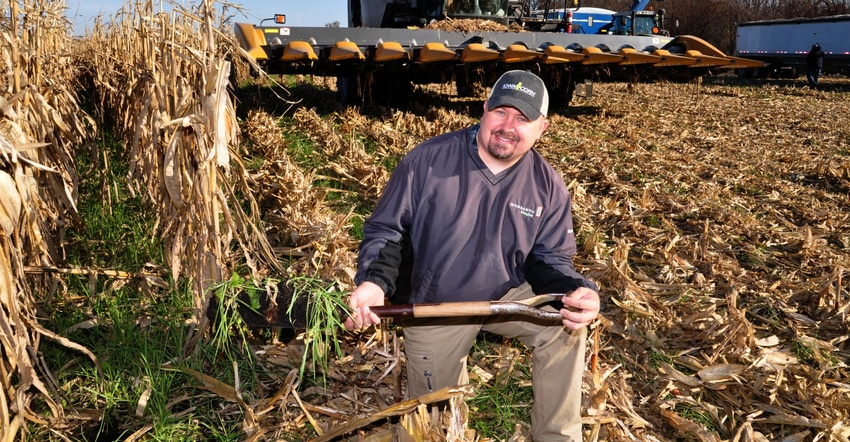January 22, 2020

More Iowa fields are turning green earlier in the spring than they used to, thanks to cover crops. To meet the challenge of reducing erosion and field runoff to improve and protect water quality, acreage seeded to cover crops continues to increase. The window for seeding in the fall depends on the corn and soybean harvest window, the weather, and the type of cover crop being planted.
Cereal rye is the most popular cover crop in Iowa because it can be planted later into the fall and endures the winter well. The advantage of cereal rye is good growth in the fall, especially if it’s established in a timely fashion, as well as growth in spring. With oats as a cover crop, it must be planted early to get fall growth, but oats won’t survive winter.
Nick Helland likes how quickly an oats cover crop grows in the fall, and he doesn’t mind that it dies over the winter. “Ahead of corn, I like a cover crop with vigorous fall growth that winterkills. The big thing is to get the oats seeded when conditions are good to kick-start germination, when they still have time to grow before harvest and winter,” he says.
Cover crop benefits add up
“The oats growth before harvest helps dry the soil out in a wet fall. Our no-till soils do hold up pretty well, but I like the way oats come through in the fall to help even more with building soil structure,” he says. “We try to be careful about harvesting on wet soils. With all that together, we’ve rarely had trouble with rutting.”
Nick and wife Cara farm with his father, Mike, uncle Charles and cousin Dustin in a 20-mile radius around Huxley in central Iowa. Last year was Nick and Cara’s first shot at cover crops, but they’ve watched his dad and uncle use them since 2012. “I’ve seen how the cover crops help control erosion and build soil, and I think there’s a little bit better weed control with cover crops, too,” he says.
To get their cover crops seeded, the Hellands have had the seed applied with an airplane in some fields, but they’ve also seeded many fields with a ground-driven Hagie highboy rig. “We’ve drilled some cereal rye, too, and that works when we’re going to no-till soybeans directly into the rye the next spring. Rye doesn’t get as much growth in the fall that way — drilled after corn harvest — but it comes on strong in the spring,” Helland notes.
Landlords like cover crops
Oats fit well with fall incorporation of hog manure — knifing it in. “I don’t worry about how that operation disrupts the growth of the cover crop like I would with rye, where we depend on spring growth,” he says.
The Hellands farm most of their land in a corn-soybean rotation. They use cover crops on about 25% of the land they farm, much of which is rented from several landlords. All their landlords have been supportive of cover crops, but most don’t share the costs. They like the fact that cover crops prevent nitrates from reaching nearby streams and rivers by scavenging and holding onto nitrates in the soil — during times when corn, soybeans and other cash crops aren’t growing.
Soil scientists point out that cover crops feed microbial life in the soil, such as fungi that produce the glue that holds soil aggregates together, forming a strong soil structure.
Betts writes from Johnston, Iowa.
About the Author(s)
You May Also Like




